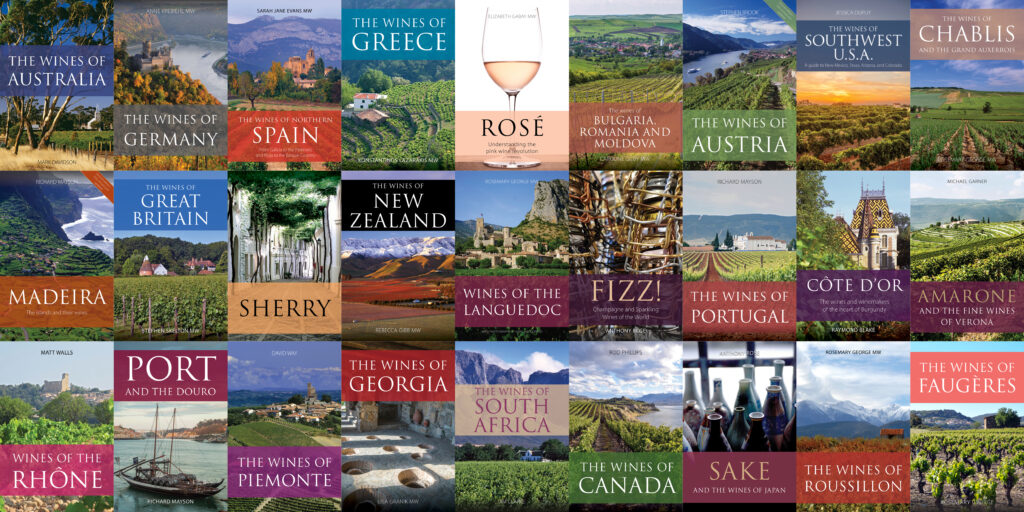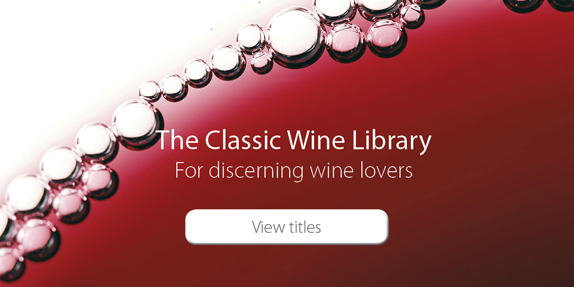Book publishing
A meeting of fine wine minds
4 December 2023 by Rebecca in Book publishing, Classic Wine Library
PRESS RELEASE: Académie du Vin Library Ltd. today announced the acquisition of the Classic Wine Library publishing list from Infinite Ideas Ltd.

This wine publishing brand of 33 titles is synonymous with quality reference guides to many of the world’s top wine regions, as well as specialist titles on history, marketing and biodynamic practices. Its list of authors includes many MWs and leading wine writers. There are more titles scheduled for publication in 2024 and 2025, including The Wines of California, Wines of the Loire Valley and The Wines of Beaujolais.
Hermione Ireland, managing director of Académie du Vin Library, said: “We are thrilled and honoured to be the new custodians for this series of books, an essential part of the wine publishing industry and its knowledge base. It will add a crucial reference aspect to our existing list that focuses more on personal stories. We have huge respect for everything that Richard Burton, with Rebecca Clare and the editorial board, have done with the brand; they have a world-beating list of authors and they continue to commission writers of the highest quality. We know our own audience will be keen to learn more about Classic Wine Library titles.
“This acquisition makes Académie du Vin Library the largest specialist wine publisher in the world and we look forward to working with retail partners, both in books and in wine, to share our great list with people who are wine-curious.”
Steve White, chairman of Infinite Ideas, said: “The Classic Wine Library will grow and prosper as part of Académie du Vin Library. We are pleased with its future prospects and believe the excellent slate of authors who have made it the most important professional list of wine books will benefit from the greater resources now available.”
A new web site for The Classic Wine Library will be launched in early 2024.
ABOUT ACADEMIE DU VIN LIBRARY
Académie du Vin Library is an imprint founded by Steven Spurrier and friends, dedicated to publishing the finest wine writing of the past, the present and the future. Our list is small and will never be large – because we value quality over quantity. We choose our books with care – above all for their readability, but also because we genuinely believe they have something important to say about the world of fine wine that will enhance your drinking pleasure.
ABOUT INFINITE IDEAS
Founded in 2003 by Richard Burton and David Grant, Infinite Ideas has built a reputation for books on wine for professionals, students and the really serious oenophile. It also publishes inspirational books on business, personal development and the arts.
For more information please contact:
Hermione Ireland at hermione.ireland@academieduvinlibrary.com or on (+44)7500 708804
The Classic Wine Library – going strong
1 May 2020 by Rebecca in Book publishing, Classic Wine Library, Current events, Wine and spirits
There is no doubt that businesses of all types are finding the current situation challenging. We wanted to reassure you that the Classic Wine Library is still here, and we are busy selling our published books as well as working hard to create new ones. We are currently preparing two books for publication in the summer: Jim Clarke’s The wines of South Africa and Jessica Dupuy’s The wines of Southwest U.S.A., which will be available in July and August, respectively.
In the meantime, we have a fantastic backlist that is now 24 books strong. If you aren’t familiar with the titles in our list, or would like to see what other books we’re hoping to bring to you in the future, take a look at our latest catalogue.
To help out those of you who are finding it hard to purchase print books we have halved the recommended retail price of our wine ebooks until the end of July. You can find them at Amazon, Apple Books, Google Play, Kobo and a range of other ebook sellers. Please note that some retailers may take longer than others to reflect the price change. You may also see further discount offered by some vendors.
And remember, you can still buy our printed books direct from us. Our warehouses in the UK and the USA are working with reduced staff numbers, as are postal services and delivery companies so it may take longer than usual for your books to reach you. Please bear with us.
Finally, do sign up to our mailing list for all the latest Classic Wine Library news. We regularly make special offers for mailing list subscribers; you can unsubscribe at any time.
Thank you for supporting informed and enlightening wine writing
The Classic Wine Library
Why we believe in experts
23 November 2018 by Rebecca in Book publishing, Classic Wine Library, Wine and spirits
Here at the Classic Wine Library we value expertise, which is why we recruited three highly knowledgeable wine experts to form our editorial board. Sarah Jane Evans MW, Richard Mayson and James Tidwell MS have all worked in various capacities in the wine industry. They understand it not just as writers and wine critics but also from the perspective of winemakers (Richard Mayson owned a vineyard in the Alto Alentejo for 15 years), sommeliers (James Tidwell co-founded TEXSOM, the US’s premiere professional beverage education event) and consumers (for ten years Sarah Jane Evans was Associate Editor of BBC Good Food magazine, where she encouraged the wider public to explore new tastes).
The three board members are well-known and well-connected within the wine world, and between them have an enviable collection of contacts, meaning they are able to introduce the best people writing about wine today to the series. Knowledgeable in their own particular subject areas they recognize expertise in others, even if the region under discussion is not one in which they are well versed. As published writers their input on content and structure is invaluable. If need be they are also there to offer advice and support to writers and act as a bridge between author and publisher (though it should be noted that the editorial team at Infinite Ideas is entirely approachable). All this goes to create books that are, as one reviewer recently remarked, consistently ‘well-structured, well-edited and rigorously researched’. But don’t worry that these books are dry collections of facts and figures, they are also immensely readable ‘fireside reads’ and ‘essential travelling companions’.
There are now 19 books in the series, with plenty more lined up for the future. If you’ve yet to experience the Classic Wine Library why not pick up one of them today and become just a little bit more expert yourself?
We love knowledgeable people so much that we want the next generation of wine experts to have the best information available to them, which is why we offer discounts on all our books to those studying for MW, WSET and GuildSomm qualifications. To find out more ask your course provider about member offers.

James Tidwell MS joins Classic Wine Library
21 September 2018 by Rebecca in Book publishing, Classic Wine Library, Wine and spirits
James Tidwell MS has joined the editorial board of the Classic Wine Library series, published by independent Oxford publisher Infinite Ideas. Tidwell, a Master Sommelier who co-founded the TEXSOM Conference, now in its fourteenth year, is a writer, speaker, consultant and entrepreneur who is expert in the worlds of wine, tea and sake. He joins current board members Sarah Jane Evans MW and Richard Mayson in working on the growing series.
Based in the USA, Tidwell will have a particular role in expanding the North American wine regions covered by the series and in increasing awareness of the Classic Wine Library among his countrymen. Joining the board James said, “This is my most treasured series, from the original Faber & Faber books to Infinite Ideas. I am thrilled to see the continuation and revitalization of the series, and am happy to be included.” The nineteenth title in the series, Anthony Rose’s Sake and the wines of Japan is published this October, along with the fourth edition of Richard Mayson’s own bestseller, Port and the Douro. Sarah Jane Evans MW was excited to be working with Tidwell, saying, “James’ knowledge is international and he brings status in the US wine community, knowledge of the current world of wine, and specifically of North American authors and the market.”
For further information on The Classic Wine Library please contact the Publisher, Richard Burton: richard@infideas.com; +44 (0)7802 443957
About James Tidwell
James Tidwell, Master Sommelier, is a writer, speaker, consultant and entrepreneur. After passing the Master Sommelier examination in 2009, he earned his Diploma from the Wine and Spirits Education Trust (WSET); Certified Wine Educator (CWE) from the Society of Wine Educators; Certified Tea Specialist from the Specialty Tea Institute, and Certified Sake Professional from the Sake Education Council. Tidwell holds a baccalaureate degree in International Trade and Finance from Louisiana State University, and earned Honours upon graduating from the Culinary Institute of America.
Tidwell co-founded the TEXSOM Conference with fellow Master Sommelier Drew Hendricks. Now in its fourteenth year, TEXSOM is the premier professional beverage education conference in the United States and among the most influential in the world. He is also Co-Owner and Producer of the TEXSOM International Wine Awards, one of America’s largest and most respected wine competitions. His writing has appeared in World of Fine Wine, Lonely Planet, Celebrated Living and The Dallas Morning News.
His industry leadership has included service on Boards of Directors and Advisory Boards for the Court of Master Sommeliers – Americas, GuildSomm, the Society of Wine Educators, the Specialty Tea Institute and the Wine and Food Foundation of Texas. He is consulting Master Sommelier with Four Seasons Hotels and Resorts in Las Colinas, Texas, which earned a Wine Spectator Best of Award of Excellence and five nominations for a James Beard Foundation Award for Outstanding Beverage Program under his direction.
Côte d’Or: the world’s greatest wine region
8 September 2017 by Rebecca in Book publishing, Classic Wine Library, Lifestyle, Wine and spirits
By Raymond Blake, author of Côte d’Or: The wines and winemakers of the heart of burgundy
Glancing behind me as I write this, at shelves loaded with wine books, I can count perhaps a dozen Classic Wine Library titles, from the black-spined Faber & Faber editions, through the less soberly jacketed Mitchell Beazley versions to the elegantly presented and up-to-date publications from Infinite Ideas. I am not sure when I bought my first one, or which it was, probably Julian Jeffs’ Sherry or Anthony Hanson’s Côte d’Or, but I am certain that without the Classic Wine Library my journey of discovery through the world of wine, from keen consumer to Wine Editor of Ireland’s Food & Wine Magazine, would have been more challenging and certainly less enjoyable. The library has been a go-to reference point for longer than I can remember.
I always regarded the Classic Wine Library like a club – not exclusive but inclusive – led by authoritative and informative writers whose knowledge and enthusiasm for their subject shone through on every page. Thus it was with great excitement that I joined the club over a year ago, commissioned to write about the wine region closest to my heart – Burgundy’s Côte d’Or. The excitement was not so great as to blind me to the challenge ahead – the labyrinthine complexity of its nomenclature alone intimidates the neophyte – but I could also call on one asset beyond value. A little over 10 years ago my wife and I were fortunate to buy a house in the Côte d’Or and since then we have visited the region dozens of times. Thus I was able to explore at leisure, chasing up the back roads, discovering unexpected delights, as well as more formally, packing in scores of visits to winemakers, from the biggest négociants to the smallest domaines.
I never – ever – tire of the Côte d’Or and I believe it is now at one of the most exciting periods in its history. That history has seen it stamped by innumerable forces, two of which – the French Revolution and the scourge of phylloxera – are largely responsible for its shape today. And perhaps now, as the memory of their trauma fades, the côte is slipping into the grip of another pair: climate change and the extraordinary surge in the prices paid for mere scraps of prestigious vineyard land. How these will shape the côte in the decades to come is still a matter for speculation, but they make every visit challenging and rewarding in equal measure.
Notwithstanding the undeniable influence of these forces, at a micro level the Côte d’Or is probably producing more high quality wine today than at any point in its history and hence it rewards repeated exploration. There is always something new to be seen, to discover, change is ever present – and this in a region that appears unchanging to the casual observer. In Côte d’Or: The wines and winemakers of the heart of Burgundy, I hope I have managed to present an early twenty-first century snapshot of an era that future historians may well come to label as a golden age – for what I consider to be the world’s greatest wine region.
Côte d’Or is published on 8 September 2017, priced £30, available from your favourite book shop. Or click here to buy your copy today.
The Classic Wine Library – picture this
14 June 2017 by Rebecca in Book publishing, Classic Wine Library, Lifestyle, Wine and spirits
One of my favourite tasks as editor of the Classic Wine Library is choosing the photos that grace the covers of the books. A great cover is essential in creating the right first impression. Reading the books makes me (and I assume others) want to sample the wines and visit the places talked about, but readers first need to be enticed into picking up the book. A beautiful and interesting cover picture can make all the difference. Picture research can sometimes be quite wearisome, particularly if you are desperately trying to depict some abstract concept in an original way. But the Classic Wine Library, with its series focus on inspiring photos of the landscapes behind the wines under discussion, is different.
It is important to have a reliable and expert supplier when purchasing such photographs. Without having visited many of the places myself how can I be sure that the photo I’m looking at is really of Roussanne vines in southern France and not Chardonnay grapes growing in South Africa? So over the last few years we’ve made this task a lot easier by working with a specialist wine photographic agency, which features a huge selection of wine-related photos from all over the world and is run by Mick Rock, a very knowledgeable and helpful, not to mention world-renowned, photographer.
But there’s more to cover design than finding a beautiful image. The title font used by our designer is called Trajan and was designed by typographer Carol Twombly. Although the font itself is less than thirty years old it is based on the inscription found on Trajan’s column, built by that Roman Emperor around the first century AD. Unlike the column’s inscription the information in these books is not carved in stone, as the world of wine is in a constant process of evolution. However we think that this elegant font, which is only available in capital letters, lends our books a certain authority and timelessness.
Over the last month we have signed up new books on the wines of New Zealand (Rebecca Gibb), Sake and other Japanese wines (Anthony Rose) and the wines of Bulgaria, Romania and Moldova (Caroline Gilby), and I am looking forward to taking virtual journeys through those countries very shortly. So watch this space for new covers. We hope you like them and find the photography as inspirational as we do.
Titles being added to the library this year include The wines of Canada, Côte-d’Or, Rosé, The wines of northern Spain, Amarone and the fine wines of Verona and The wines of Greece. You can find out more here and order published books at 20% discount here.

